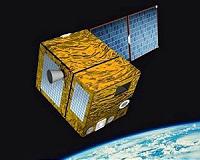 |
Paris, France (ESA) Jan 11, 2010 Space technologies have led to a number of inventions that benefit the environment and save energy. Satellite-based systems are reducing vehicles' carbon dioxide emissions, remote-sensing technology is making wind turbines more efficient, and information from weather satellites is helping solar cells to produce more energy. These are just some examples of how spin-offs from space technology and satellite services can make a difference. Over the years, ESA's Technology Transfer Programme and its Business Incubation Centres have fostered and supported many innovative technologies and business ideas that contribute to new services and products to mitigate climate change.
Space tech for renewable energy ESA's expertise from this mission was important for Leosphere and was used to improve their instrument during the company's start-up phase at ESA's Business Incubation Centre (BIC) in Noordwijk, the Netherlands. More instruments based on the same technology have followed and these are now being used in more than 100 countries. By using data from weather satellites, 'SolarSAT' from Italian company Flyby can accurately predict the power output of photovoltaic power plants. This information is used to design improved systems and quickly identify faults in operating photovoltaic plants - faults that can reduce energy production by more than 10% a year. This system has already been installed on several photovoltaic systems in Italy.
Space sensors reduce emissions from heating systems "It can reduce exhaust gases that are harmful for the environment and ensure that heating systems work at an optimum level. It also reduces fuel consumption by 10-15%," explained Rainer Baumann from TU Dresden. Supported by ESA's Technology Transfer Programme and its partner MST, this technology is now used by the German company ESCUBE in systems controlling industrial heaters.
Satellite data reduces car emissions Repeated rapid acceleration and abrupt braking increases the fuel consumption of even the greenest car. Alex Ackerman and Yossef Shiri have developed the intelligent GreenDrive system that combines information on the type of car, its location and the road conditions to advise the driver on the most economical driving style to use: when to accelerate, when to brake and when to keep the speed constant. On average, this can result in a 15-25% fuel saving. Another system proposed by Prof. Gerhard Guttler for the European Satellite Navigation Competition is Galileo-Ecodrive. This uses data on a road's geodetic height profile provided by satnav systems to optimise the operation of auxiliary devices such as electricity generators, air conditioning, power steering, the deep freezers used on trucks for perishable goods and the moveable parts of a cement mixer -devices that consume up to 20% of the fuel. This could amount to savings of up to 2 billion litres a year across Europe, avoiding the emission of 5 million tonnes of carbon dioxide.
Changing lifestyles Carbon Diem runs on a mobile phone. "The beauty of our system is that it's easy, when you make the effort to walk instead of taking the car you can immediately see the result which should encourage you to stick with it," says Mr Zachariah.
Share This Article With Planet Earth
Related Links ESA's Technology Transfer Programme Office (TTPO) Earth Observation News - Suppiliers, Technology and Application
 The PARASOL Satellite Moving Off The A-Train Track
The PARASOL Satellite Moving Off The A-Train TrackWashington DC (SPX) Jan 05, 2010 After nearly 5 years of concurrent operations with the Afternoon Constellation, known as the "A-Train," the PARASOL satellite is going on another orbit "track." The A-Train includes a number of NASA satellites that orbit the Earth one behind the other on the same track and until this month, PARASOL has been part of that train. PARASOL is an Earth observation mission, managed by the French ... read more |
|
| The content herein, unless otherwise known to be public domain, are Copyright 1995-2009 - SpaceDaily. AFP and UPI Wire Stories are copyright Agence France-Presse and United Press International. ESA Portal Reports are copyright European Space Agency. All NASA sourced material is public domain. Additional copyrights may apply in whole or part to other bona fide parties. Advertising does not imply endorsement,agreement or approval of any opinions, statements or information provided by SpaceDaily on any Web page published or hosted by SpaceDaily. Privacy Statement |